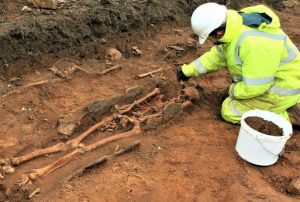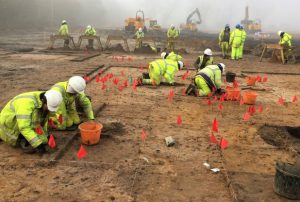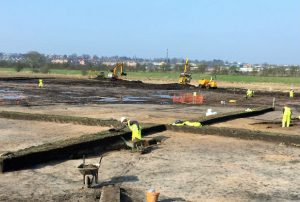Archaeologists conducting excavations at a site prior to construction of Lincoln Eastern Bypass near near Washingborough Road in found in Lincolnshire, England, have found more than 150 skeletons and artefacts dating back even 12000 years.

The researchers documented artefacts and features from every major time period, including Mesolithic, Neolithic, Bronze Age, Iron Age, Roman, Anglo-Saxon, Medieval, and Post-Medieval. The number of artefacts rounds up to about 40000 items. The oldest remains come from after the last ice age, 12000 to 6000 years ago, when small groups of people regularly hunted, foraged and fished by the side of the Witham river, making and using their stone tools. According to archaeologists thousands of flints have been recovered, including flint knives and scrapers. It may well be the largest Mesolithic site ever discovered in Lincolnshire.

In the Neolithic, dating between 6,000-4500 years ago, the first farmers also used flint tools. Thousands have been found, including a polished flint axe-head, used for clearing trees for agriculture. A group of large earthen monuments, in form of round barrows, made during the Bronze Age (4500-3000 years ago) still just survive as raised mounds alongside the Witham. In one of the barrows a complete pottery urn containing a cremated human body has been found. Later, a small settlement in the Iron Age (1000 BC-43 AD) existed close to where Washingborough Road now runs.

Some of the archaeological features date back to the Roman period (43-410 AD) as a possible Roman villa complete with underfloor heating has also been discovered along with Roman graves and three Bronze Age burial round barrows and the remains of a medieval monastic grange including a 12th century look-out tower. It is possible that the villa emerged substantially from the Iron Age settlement.

The skeletons, which were found in a number of over 150, come from the Middle-Saxon period (700-900 AD). These bodies were buried east-to-west without any grave goods, in the Christian tradition. Christianity continued at the site with the establishment of a Medieval monastic grange dated to 1066-1540 AD. The remains of stone buildings, wells, trackways and ovens have been found, as well as malting kilns, for beer-making, and the base of a square look-out tower. After the Dissolution of the Monasteries (1536-1541 AD) the land became a farmstead known as Sheepwash Grange, and the foundations of stone buildings and barns have been uncovered, along with cobbled yards and wells.

(after Lincolnshire Live)